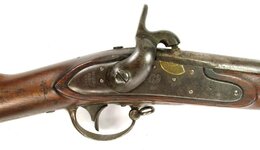halfdime
Silver Member
Last week I posted, among a few other items, an 1838 large cent from an old homestead in the neighborhood where I grew up. Before I started, another neighbor told me about the "musket" found on the property I was about to do. Today, I went over to do some more detecting and some of the surviving family was there. The father died just about a month ago; it was he who found the gun in question. One of the sons-in-law went to a shed and pulled it out to show me; I was duly impressed. I was a history major and don't know much about guns but I can appreciate the history of most artifacts. I was happy to see it, but I didn't do cartwheels; I figured the gun had to be at least a hundred years old, probably more, so I appreciated it from that perspective and thanked the host for showing it to me. He put it away and came back out a few minutes later and gave it to me! That was the furthest thing from my mind when I first saw it; I certainly didn't covet it or hold it tight to my chest. Evidently, the deceased had found it while digging for some project in his yard; there was an old homestead a few hundred feet away and we figure that anything "older" was associated with it. For example, the 1951 Washington quarter found there today wasn't . Is this today's find? No. Could have been, had it not been found already
. Is this today's find? No. Could have been, had it not been found already . I hope the pictures help with identification.
. I hope the pictures help with identification.
 . Is this today's find? No. Could have been, had it not been found already
. Is this today's find? No. Could have been, had it not been found already . I hope the pictures help with identification.
. I hope the pictures help with identification.Amazon Forum Fav 👍
Attachments
Upvote
8







 very interesting
very interesting 



